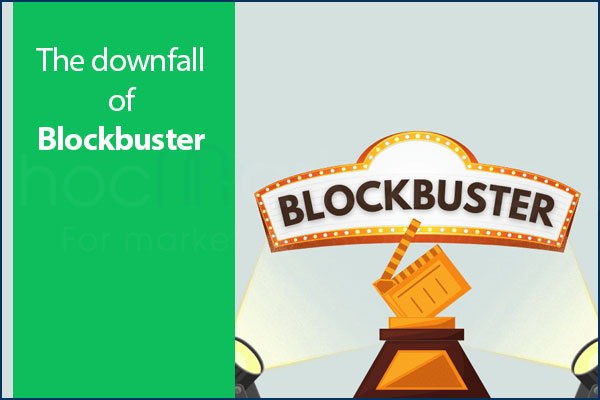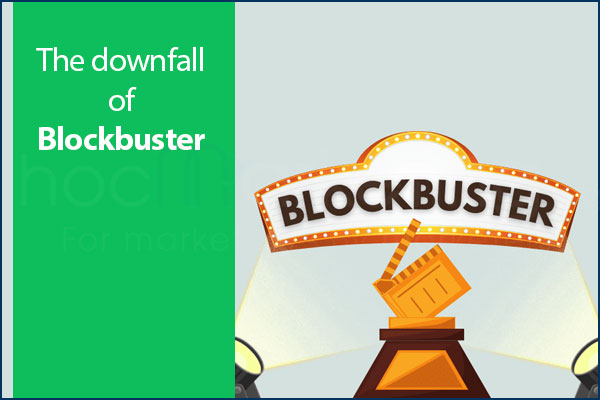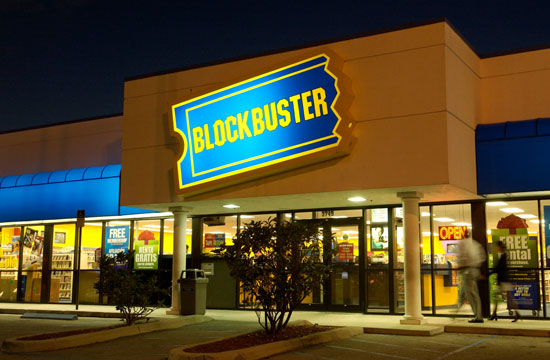
The downfall of Blockbuster

Blockbuster was once a household name and a leading player in the entertainment industry. The company was founded in 1985 and quickly became the go-to destination for movie rentals. At its peak, Blockbuster had over 9,000 stores worldwide, making it the largest video rental chain in the world.
Blockbuster was once a household name and a leading player in the entertainment industry. The company was founded in 1985 and quickly became the go-to destination for movie rentals. At its peak, Blockbuster had over 9,000 stores worldwide, making it the largest video rental chain in the world.
However, the rise of streaming services and the digital age changed the way people consumed entertainment, which ultimately led to the downfall of Blockbuster. In this blog post, we will explore the development process of Blockbuster, its golden age, and how the company's inability to adapt to changing times led to its fall and late regrets. Let's dive in and discover the fascinating story of Blockbuster's rise and fall.
Brief about Blockbuster
Blockbuster was a popular video rental store that was founded in 1985 in Dallas, Texas. The company quickly rose to become one of the largest video rental chains in the world, with over 9,000 stores in 25 countries at its peak. The company was known for its extensive collection of movies, video games, and other entertainment media, and was a go-to destination for movie enthusiasts.
Blockbuster's unique business model was based on the concept of renting out videos for a specified period. Customers would visit the store, browse the available titles, and rent the movies they wanted to watch. Blockbuster's success was largely due to its wide selection of videos, competitive pricing, and convenient store locations.
Despite being a leader in the video rental industry, Blockbuster failed to adapt to the changing market trends and eventually went bankrupt in 2010. In this blog post, we will take a closer look at the rise and fall of Blockbuster, and explore the factors that led to its eventual downfall.
Blockbuster's development process
Blockbuster was founded in 1985 by David Cook, who saw an opportunity to create a retail store that rented VHS tapes to consumers. The company quickly grew, with stores popping up all over the United States and eventually expanding globally. However, the journey to success was not without its challenges.
In the early days, Blockbuster faced stiff competition from smaller video rental stores. To differentiate itself, Blockbuster introduced a new pricing model that charged late fees for overdue rentals. This resulted in significantly increased revenue for the company and helped to establish its dominance in the industry.
Blockbuster's development process also included a focus on customer service. The company invested heavily in training its employees to provide a high level of service to customers, including personalized recommendations for movies and easy-to-navigate store layouts.
As Blockbuster continued to grow, it expanded its offerings to include not only VHS tapes but also DVDs, video games, and other related products. The company also began to experiment with new store formats, such as Blockbuster Express kiosks and Blockbuster Online.
Overall, Blockbuster's development process was marked by a focus on innovation, customer service, and a willingness to adapt to changing market conditions. These factors contributed to the company's success during its Golden Age and helped to establish it as a leader in the video rental industry.
Blockbuster's Golden Age
During the 1990s, Blockbuster was the king of the movie rental industry. It was a time when people would flock to Blockbuster stores to rent the latest blockbuster movies. At its peak, Blockbuster had over 9,000 stores worldwide and was valued at $8.4 billion.
One of the reasons for Blockbuster's success during this period was its innovative approach to movie rental. The company introduced the concept of "new releases", where the latest movies would be available for rent exclusively at Blockbuster stores for a period of time before being made available to other rental outlets.
Blockbuster also had a wide selection of movies and TV shows, which made it a one-stop-shop for all entertainment needs. The company had a loyalty program that rewarded frequent customers with free rentals and discounts.
Blockbuster's Golden Age was also marked by its aggressive expansion strategy. The company opened new stores at a rapid pace, often acquiring smaller movie rental chains to expand its footprint. Blockbuster's dominance in the industry was such that it was often accused of using anti-competitive tactics to drive smaller competitors out of business.
Overall, the period from the late 1980s to the early 2000s was Blockbuster's Golden Age. The company was at the forefront of the movie rental industry and was a household name across the world. However, as we will see in the next section, this was not to last.
Streaming service appears and Blockbuster's reaction
The emergence of streaming services, such as Netflix and Hulu, marked a significant turning point in the entertainment industry. Blockbuster, initially, was slow to react to this shift in consumer behavior. In 2004, Blockbuster CEO John Antioco declined an opportunity to purchase Netflix for $50 million, which would have allowed Blockbuster to enter the streaming market early on.
Instead, Blockbuster continued to focus on its brick-and-mortar stores, offering customers the option to rent DVDs and video games. However, as streaming services gained popularity, Blockbuster's sales began to decline rapidly. The company attempted to enter the streaming market with its own service, Blockbuster On Demand, but it was too little, too late.
Blockbuster's late response to the streaming trend ultimately cost the company its dominance in the entertainment industry. By the time Blockbuster began to focus on streaming, Netflix had already established itself as the leader in the market, with a wider selection of content and a more convenient user experience.
In conclusion, Blockbuster's lack of foresight and slow response to the emergence of streaming services ultimately led to its downfall. The company's inability to adapt to changing consumer behavior serves as a cautionary tale for businesses across all industries.
The phase of losing market share of Blockbuster
Section 5) The Phase of Losing Market Share of Blockbuster
After Blockbuster's initial success, the company began to face a series of challenges that ultimately led to its downfall. One of the primary factors that contributed to Blockbuster's decline was the emergence of new technologies and business models that disrupted the traditional video rental industry.
As streaming services like Netflix and Hulu started to gain popularity in the early 2000s, Blockbuster was slow to respond. The company initially dismissed the threat of streaming, believing that its brick-and-mortar stores and DVD rental model would continue to dominate the market.
However, as more and more consumers began to shift towards digital media, Blockbuster's market share started to decline rapidly. By 2010, the company had lost significant ground to competitors like Netflix and Redbox, and was struggling to keep up with the rapid pace of technological change.
Despite attempts to pivot and offer streaming services of their own, Blockbuster was never able to regain the market dominance it once enjoyed. By 2013, the company had filed for bankruptcy and closed its remaining stores.
The downfall of Blockbuster serves as a cautionary tale for businesses that fail to adapt to changing market conditions. As new technologies and business models continue to emerge, it's essential for companies to remain agile and responsive to stay competitive in today's fast-paced digital landscape.
Blockbuster's Fall and Late Regrets
Despite Blockbuster's initial efforts to adapt to the changing market, the company eventually faced a rapid decline in the early 2000s. Netflix, which started as a DVD-by-mail service, began offering streaming services in 2007, marking the beginning of the end for Blockbuster.
Blockbuster attempted to enter the streaming market with their own service, but it was too little too late. The company also faced financial struggles and was unable to compete with Netflix's lower prices and convenience.
In 2010, Blockbuster filed for bankruptcy and closed thousands of stores worldwide. The company's fall from grace was a stark reminder of the importance of adapting to market changes and staying ahead of the competition.
Late regrets from Blockbuster executives included not investing in Netflix early on, not offering their own streaming service sooner, and not embracing the new digital age of media consumption. These regrets serve as a cautionary tale for all businesses to stay vigilant and adaptable in a constantly shifting market.
Summary
In conclusion, the downfall of Blockbuster was a result of their inability to adapt to changing times and technologies. Despite being a dominant force in the entertainment industry for decades, they failed to recognize the potential of streaming services and underestimated their impact on the market. As a result, they lost their market share and eventually went bankrupt. Blockbuster's fall serves as a cautionary tale for businesses that fail to embrace change and innovation. It highlights the importance of staying ahead of the curve and being open to new ideas and technologies. The legacy of Blockbuster will live on, but it will forever be remembered as a company that failed to evolve with the times.















